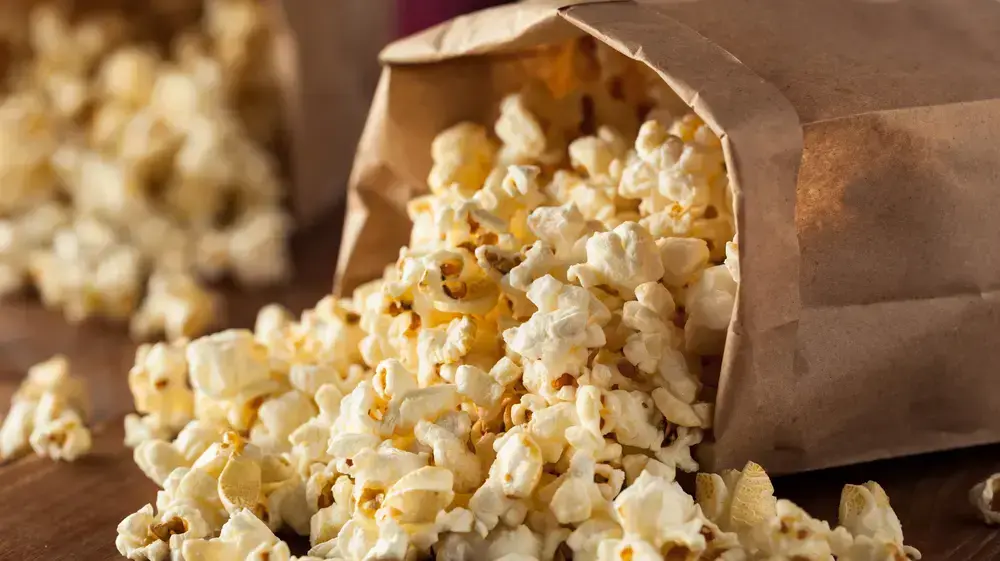In covid-19 times, the fast food problem 1:22
(CNN) - What is the first thing you should worry about when you look at the packaging of your fast food or your take-away order?
No, it is not the coronavirus: science assures us that the risk of contracting covid-19 in this way is minuscule.
Instead, worry about the toxic chemicals lining your fast-food hamburger wrappers or the molded fiber container filled with salad or vegetables, says a new report from environmental advocacy groups Toxic-Free Future and Mind the Store. It is a campaign led by Safer Chemicals, Healthy Families to encourage manufacturers to avoid toxic chemicals in products.
The report, titled "Contaminated Packaging: Are PFAS Food Chains Using Packaging?" Was released Thursday.
The tests carried out by the groups revealed the existence of toxic substances PFAS (man-made perfluoroalkyl and polyfluoroalkyl chemicals) in the packaging of Burger King's Whoppers, chicken nuggets and biscuits; in Wendy's paper bags; and in McDonald's "Big Mac" wrappers, chips, and cookies.
“As the world's largest fast food chain, McDonald's has a responsibility to its customers to keep them safe. These dangerous chemicals should not be in food packaging. For my part, I am NOT 'loving' him, "Mike Schade, campaign manager for Mind the Store, said in a statement, referring to the McDonald's I'm lovin it slogan.
In addition, molded fiber containers labeled "environmentally friendly" sold by Mediterranean food chain Cava, Canadian restaurant franchise Freshii and fast salad chain Sweetgreen scored extremely high PFAS scores, according to the report.
In fact, the fiberglass packaging showed the highest levels of any packaging tested.
- LOOK: This is how I change the way we consume fast food because of the covid-19
"Ecologically friendly does not mean friendly to human health. Those are two different considerations, "said Dr. Leonardo Trasande, chief of Environmental Pediatrics at NYU Langone, who was not involved in the study. "This example in the report really makes it clear to us," he added.
However, not all of the packaging tested contained these dangerous chemicals. The report found that the cardboard containers for potato chips and fried chicken pieces sold at the three hamburger chains were below detection level.
The graph shows the number of stores in the US and Canada.
"This is a very clear demonstration that the chemicals in our food packaging do not have to be," said microbiologist Linda Birnbaum, former director of the National Institute of Environmental Health Sciences and the National Toxicology Program.
"In other words, you can do things that don't have to have this," said Birnbaum, who was not involved in the report.
Today, Cava announced that it will remove PFAS from its food packaging by mid-2021, while Sweetgreen announced in March that it would remove the chemicals by the end of the year. Freshii told CNN that he was transitioning to two sizes of pulp bowls without PFAS by early 2021.
McDonald's Corporation issued the following statement: “We have removed significant subsets of PFAS from McDonald's food packaging worldwide. We know that more progress must be made across the industry and we are exploring opportunities with our supplier partners to go further. ”
CNN contacted the other two companies, but did not receive a response before the publication deadline.
What are PFAS?
PFAS chemicals are made of a chain of linked carbon and fluorine atoms, which do not degrade in the environment.
"In fact, scientists cannot estimate an environmental half-life for PFAS, which is the amount of time it takes for 50% of the chemical to disappear," according to the National Institute of Environmental Health Sciences.
While two of the most widespread PFASs - 8-carbon chain perfluorooctanoic acid (PFOA) and perfluorooctane sulfonate (PFOS) - were removed from consumer products in the United States in the early 2000s, the industry has Generated many more: More than 4,700 types of PFAS existed in 2018, a number that increases as the industry invents new forms.
PFAS chemicals are used in all kinds of products we use: nonstick cookware, infection resistant surgical gowns and drapes, cell phones, semiconductors, commercial aircraft, and low emission vehicles.
Chemicals are also used to make carpets, clothes, furniture, and food packaging resistant to stains, water, and grease damage. Foods that contain a lot of fat, like hamburgers, fries, and cookies, are great candidates for PFAS wrappers.
- MIRA: Minors will not be able to buy junk food in Oaxaca
"Maybe that's something all consumers should think about," said Birnbaum. «Is it more important to have PFAS wrappers in our food to prevent fat from penetrating? Or do we just accept that as something we have to deal with? ”He explained.
PFAS chemicals in food wrappers and containers are part of the newer generation, made with 4- or 6-carbon chains to replace the rejected versions of 8-carbon PFOA and PFOS.
However, the newer forms appear to have many of the dangerous health effects than previous versions, experts say, leaving consumers and the environment still at risk.
"So they went to shorter carbon chains, and you study them, and they do almost the same thing," said Birnbaum. Why would we think that you can make a very small change in a molecule that you are making and that the body would not react in the same way? He asked himself.
Studies also show that newer PFAS chemicals can migrate to food more easily than older forms.
"This is a pattern of what has been happening," added Birnbaum. "Some people call it the 'Wack-a-Mole' problem, others call it the chemical conveyor belt. We really don't require adequate security testing before things hit the market, "he said.
It's also difficult to keep track of substances at this rate, Trasande added.
"It does not mean that there are no others on the way who may have the same type of problems," he said. "Because we innovate our chemical structures, and that can help overcome the regulatory gap in the United States Food and Drug Administration (FDA) and achieve usability for food contact."
PFAS Chemical Health Hazards
There is ample evidence of the damage that PFAS substances can cause to the body as well as to the environment. Research in the past decade has found that exposure to PFAS is associated with liver damage, immune disorders, cancer, and endocrine disruption, meaning that they mimic or interfere with the body's natural hormonal processes.
Endocrine disruptors - such as the infamous DDT and dioxin pesticides, plastic additives Bisphenol A (BPA), and phthalates - join PFAS chemicals in their link to developmental, reproductive, brain, immune, and other problems, according to the National Institute of Environmental Sciences.
A major review published in the Lancet Diabetes and Endocrinology journal last month lists studies linking endocrine-disrupting chemicals with semen damage and prostate cancer in men, breast cancer, polycystic ovary syndrome, and endometriosis in women, childhood obesity, and adult and more.
PFAS has been detected in the blood of 97% of Americans, according to a 2015 report by the Centers for Disease Control and Prevention.
The packaging continues to harm the environment and human health after being disposed of, contaminating drinking water, food and the air. Even if a person avoids PFAS chemicals in their own home, evidence shows that these chemicals still enter the environment, experts say, where they can find their way to reach people.
Many more examples
This is not the first report that finds these chemicals in our food packaging.
A 2017 study examined 400 samples of food wrappers, cartons, and beverage containers from fast-food restaurants across the United States. The paper cups were unpolluted, but 56% of the dessert and bread wrappers, 38% of the sandwich and hamburger wrappers, and 20% of the cardboard wrappers (the type used to hold chips, for example ) contained detectable levels of PFAS chemicals.
More than a third of the samples analyzed revealed levels well above what is considered acceptable, the study found.
In late 2018, Safer Chemicals Healthy Families and Toxic-Free Future released a report titled “Toxic To Go: PFAS Chemicals in Food Wrapping,” in which they found evidence of PFAS chemicals in nearly two-thirds of the takeaway paper containers. , such as those used in self-service salad buffets and hot bars.
In response, Whole Foods became the first supermarket chain in North America to publicly commit to removing PFAS chemicals from takeout containers and the role of deli and bakeries. Other brands like Trader Joe's, Panera Bread and Ahold Delhaize have made progress, but Mind the Store's latest retail ranking still gives 18 retailers an 'F', including giants Burger King, McDonald's, Popeyes, Publix, Starbucks and Subway.
"The main reason it has been slow is not the lack of effort by these nonprofits or the lack of consumer concern, but because the FDA does not require that these products be tested systematically," Trasande said.
"They hit the market without the kind of toxicology tests and pre-market security tests we really need," he explained.
Pocket power
What can be done? It turns out that consumers have a lot of influence when it comes to voting with their pockets.
"When the consumer rejects, it makes a difference," said Birnbaum. "For example, Home Depot announced last year that they were no longer going to sell stain resistant carpets because they were being rejected by buyers," he explained.
"The same thing happened with flame retardants in mattresses about 10 or 15 years ago, when people said, 'I don't want to find flame retardants in my mattress,'" he added. "And the reason the FDA finally banned BPA from bottles and spill cups was because new mothers said, 'I don't want BPA around my baby,' and they refused to buy things that had it."
Trasande agrees: “The little data that has been released has caused a relatively rapid change. I remember when one of the reports appeared about two supermarket chains with their buffet-style food packaging. And literally weeks later on Instagram and Facebook they announced they had traded their materials for PFAS-free ones. ”
"We know that companies respond to consumer concerns because they are linked to profit margin and market share," said Trasande.
States have been on the front line of pressure for change. The states of Washington and Maine, and the cities of Berkley and San Francisco, banned PFAS in paper food packaging a few years ago. New York is in the process of banning it this year. Two representatives of Congress introduced the "Keep Food Containers Safe from PFAS Act" last year, but no action has been taken.
Last week, the FDA announced a voluntary agreement with three paper manufacturers, saying they will begin to phase out some synthetic chemicals used in food packaging materials in the next three to five years. The FDA also noted that in 2019 a fourth manufacturer suspended sales of certain PFAS products in the U.S. market.
These moves come after an FDA analysis earlier this year that showed that certain PFAS chemicals used in food packaging could be found in drinking water and a finding last year that the chemicals were persistent in human diets. .
More needs to be done, experts say, which requires educating the public about the dangers of PFAS chemicals to human health and the environment.
"I don't think people necessarily want chemicals in their food that are going to get into their bodies and that may cause health effects or last a long, long time in the environment," said Birnbaum. "But I don't think people know that," he said.
CNN's Nadia Kounag contributed to this report.
Burger King Junk Food McDonald's





/cloudfront-eu-central-1.images.arcpublishing.com/prisa/ILLMSM3CL5EZTGR5TPAFNGGS6Y.jpg)









